Top 5 Brand Localization Examples That Actually Worked
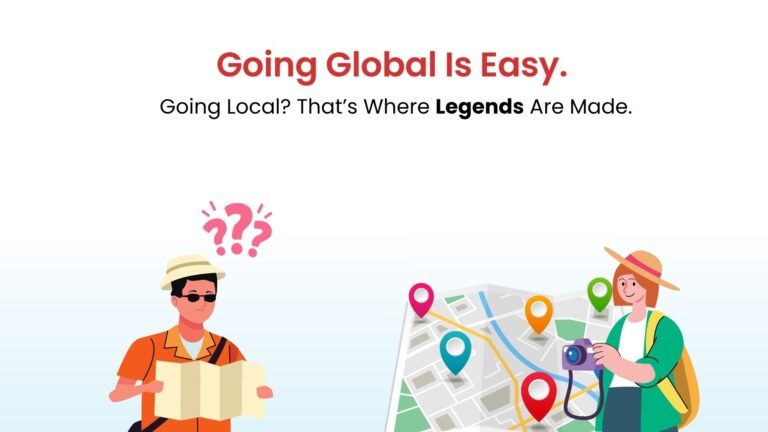
Going “global” is every brand’s wet dream.
- A glossy campaign,
- A billion new eyeballs,
- Sales graphs shooting up like crypto in a bull run.
But most brands trip on the same banana peel: they forget that global ≠ universal.
What crushes it in New York can flop harder than a Bollywood remake in Tokyo. That’s where brand localization struts in like the cool kid who actually knows what the locals eat, wear, binge-watch, and swear by.
Too often, brands mistake localization for swapping words or running campaigns through translation software.
What they forget is- that people don’t buy into words alone, they buy into emotions. It’s about how people celebrate, how they argue, how they joke, and how they mourn.
It’s like joining a conversation at a dinner table, full of strangers. If you barge in with your own stories without noticing what others are talking about, you’ll sound out of place. But if you listen first, catch the humor, the pauses, the unspoken rules, then it will be much easier to blend in.
————————————————————————————————————————-
Netflix didn’t just dump American shows in Spain, they poured cash into Spanish originals that now stream worldwide.
KFC in China? They didn’t push buckets of greasy fried chicken; they studied the palette and ended up serving everything from congee to egg tarts.
That’s not just marketing; that’s cultural espionage done right.
Here’s the fun part: while everyone worships the usual suspects (McDonald’s and Coca-Cola), there are brands out there doing next-level localization that’ll make you go: Damn, why didn’t I think of that?
They’re not just selling; they’re embedding themselves into the culture, becoming part of the local story instead of a foreign narrator.
So buckle up. This isn’t another “5 tips for going global” yawn-fest. We’re talking five real brands that mastered the art of fitting in without selling out.
Brand Localization Examples that are bold, weird, and in some cases, ridiculously smart.
Because going global is easy.
Going local? That’s where legends are made.
1. LEGO brand localization in China – From Plastic Bricks to Cultural Bridges
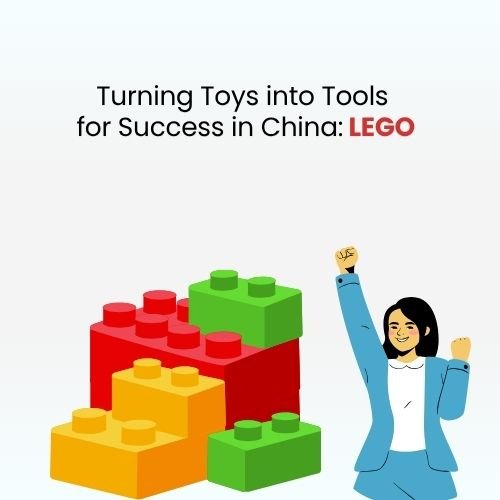
What LEGO is:
LEGO is that Danish toy brand famous for colorful interlocking plastic bricks that let kids (and adults) build anything from castles to spaceships.
Their Brand Localization Strategy:
When Lego rolled into China, they weren’t just competing with other toys. They were battling a market swamped with cheap knock-offs that looked like Lego, clicked like Lego, but weren’t Lego. Any other brand would’ve screamed, “Copycats!” and lawyered up. But Lego? They played the long game.
Instead of sulking, Lego went Sherlock Holmes on Chinese parenting culture. They learned that Chinese parents aren’t just buying toys; they’re buying status, smarts, and skills for their kids. So Lego flipped the script: it wasn’t just a toy, it was a tool to build creativity, problem-solving, and even future careers. They opened flagship stores that felt like theme parks and tied Lego play to educational benefits.
The result:
Parents saw Lego not as another plastic brick set but as a ticket to raising sharper, more confident kids. Copycats could never sell that story.
Here’s how Lego nailed the localization game:
What Worked | What Didn’t Matter |
Positioning Lego as an educational tool | Fighting copycats head-on |
Aligning with parental ambitions in China | Selling it only as “fun” |
Opening immersive, experiential flagship stores | Simple shelf presence |
Lego didn’t just build castles out of bricks in China — they built trust. And that’s a stronger foundation than plastic.
2. Nintendo’s Animal Crossing – Escaping to Local Joy
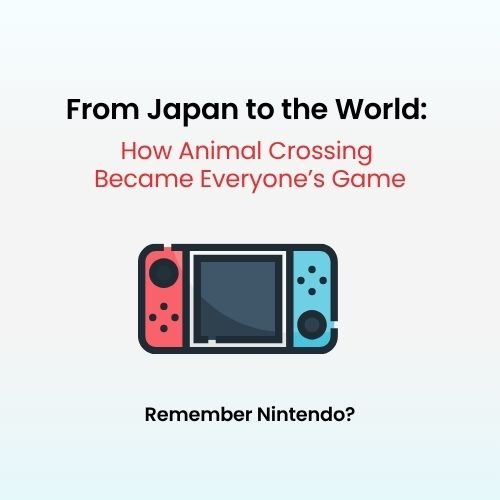
What Nintendo is:
A Japanese gaming giant behind classics like Mario, Zelda, and Pokémon.
Their Brand Localization Strategy: :
If 2020 had a mascot, it was a tiny villager in Animal Crossing. While the world melted down, millions found zen gardening, fishing, and debt-free mortgages (take notes, real banks) in Nintendo’s island utopia.
But here’s the kicker: Nintendo didn’t just ship a “Japanese game” and hope for the best. They made Animal Crossing a blank cultural canvas. Different markets got localized festivals, dialogues, and even memes baked right into the gameplay. Players in China could celebrate Lunar New Year, while in the West, they were decking out islands for Halloween.
The genius:
Instead of forcing players into a one-size-fits-all vibe, Nintendo gave every culture a chance to see themselves in the game. It wasn’t “Japan’s game exported.” It was “your community, but cuter.”
Localization wins like this made Animal Crossing feel less like a game and more like a lifestyle.
What Worked | What Wasn’t the Point |
Adapting in-game events to local cultures | Overcomplicating with hyper-realism |
Creating relatable, local-friendly dialogues | Making it all about graphics |
Offering a customizable, blank-canvas platform | Forcing one cultural narrative |
Nintendo proved that sometimes the best way to go global is to hand locals the paintbrush.
3. Polygon’s Wolfenstein II – The Mustache That Sparked a Culture Clash
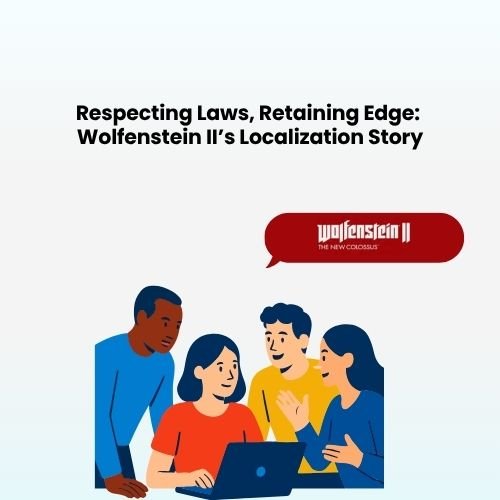
What Wolfenstein is:
A long-running video game franchise about fighting Nazis, developed by MachineGames and published by Bethesda.
Their Brand Localization Strategy: :
Marketing a video game where you fight Nazis wasn’t the easiest sell. And when Wolfenstein II: The New Colossus launched in Germany, it hit a big roadblock: the country had strict laws that banned swastikas and direct depictions of Hitler.
So what did Polygon (the publisher) do?
They didn’t cry about “censorship” or release a watered-down campaign. They did something hilarious and very German-friendly: they gave Hitler a shave.
Literally, the German version axed the Führer’s iconic mustache and scrubbed all Nazi symbols, transforming the dictator into just another cranky old man.
Players still got the same adrenaline rush, but without the cultural/legal minefield. Instead of losing flavor, the campaign gained swagger. It showed respect for local laws and gave gamers something to smirk about.
What Worked | What Would’ve Flopped |
Clever censorship (Hitler without a mustache) | Ignoring German sensitivities |
Retaining the game’s core story and intensity | Stripping out entire storylines |
Turning a legal hurdle into a viral talking point | Complaining about “creative freedom” |
This wasn’t dilution. It was localization with attitude. Wolfenstein didn’t lose its edge – it sharpened it for a new audience.
4. Heineken in Africa – Beer Meets Football
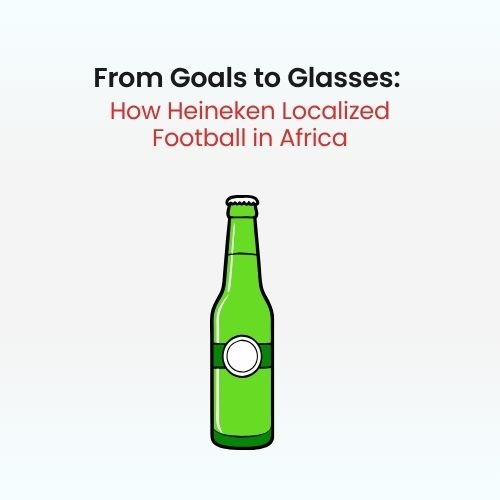
What Heineken is:
A Dutch beer brand, one of the biggest in the world, famous for its green bottles and red star.
Their Brand Localization Strategy:
Heineken knew Africa was obsessed with the beautiful game of Football, but simply putting on a Champions League logo on a bottle wasn’t going to cut it. Fans there don’t just watch football; they live it, breathe it, and sometimes argue about it like it’s politics.
So Heineken localized with laser precision. They created campaigns that brought European football closer to African fans: interactive fan zones, localized viewing parties, and marketing that spoke to passion, not just pints.
They even tapped into local commentary styles- turning matches into shared, emotional rollercoasters that felt homegrown, not imported.
The brilliance:
Heineken wasn’t just selling beer; they were selling belonging. In markets where football is practically a religion, Heineken turned itself into the beer you drink that you cannot do without, when you’re watching it.
What Worked | What Would’ve Flopped |
Tying beer directly to football culture | Generic “drink responsibly” ads |
Hosting immersive, local fan experiences | Copy-pasting European campaigns |
Embracing local commentary & fan styles | Over-reliance on star endorsements |
Heineken didn’t just sponsor the game – they became part of the fandom. And in Africa, that’s bigger than any billboard.
5. IKEA in Saudi Arabia – Flatpacks Meet Culture

What IKEA is:
A Swedish furniture retailer, famous for affordable flat-pack furniture and minimalist Scandinavian design.
Their Brand Localization Strategy: :
IKEA has always been the brand that teaches you two things: patience and the metric system. But in Saudi Arabia, they knew selling flat-pack furniture meant more than just storage hacks and Allen keys.
Saudi homes are built around big families, gatherings, and cultural norms that emphasize privacy and gender roles. So IKEA reimagined its catalog and showrooms to reflect that. They featured larger dining setups, family-centric living spaces, and even made tweaks to imagery to fit cultural expectations.
It wasn’t IKEA telling Saudis, “Here’s how to live.” It was IKEA saying, “We get how you live, and we’ve got furniture that fits right in.” That humility turned a foreign brand into a household friend.
What Worked | What Would’ve Bombed |
Designing catalogs that reflect Saudi culture | Exporting the Swedish template untouched |
Offering family-centric product setups | Only pushing solo-living solutions |
Adapting in-store experiences to local needs | Ignoring cultural sensitivities |
IKEA didn’t just drop flat-packs in Riyadh. They localized their way into living rooms literally.
Signing Off:
So, what are the key takeaways from the luxury brand localization strategies that we discussed above?
It’s this: Culture isn’t a footnote in marketing- it is the marketing.
You can spend millions shouting your message in the slickest campaigns, but if you miss the rhythm of the culture you’re stepping into, the music just won’t land.
No one in Shanghai was begging Lego to set up shop, but Lego found a way to connect play with education, and suddenly the brand became less “plastic bricks from the West” and more “a smarter way to raise kids.” That’s the power of alignment.
Nintendo, Polygon, Heineken, IKEA- all of them bent, adapted, and sometimes sacrificed their original ideas, just because they wanted to be understood.
And that’s the heart of it: understanding beats translation. Empathy trumps consistency.
Localization isn’t just a business strategy- it’s a brand’s way of saying, “We see you, we respect you, we’re here with you.” And when a brand gets that right, people don’t just buy the product- they invite it into their lives.
Let your brand speak globally
For customized brand localization services for your brand-
Connect with our expert today
